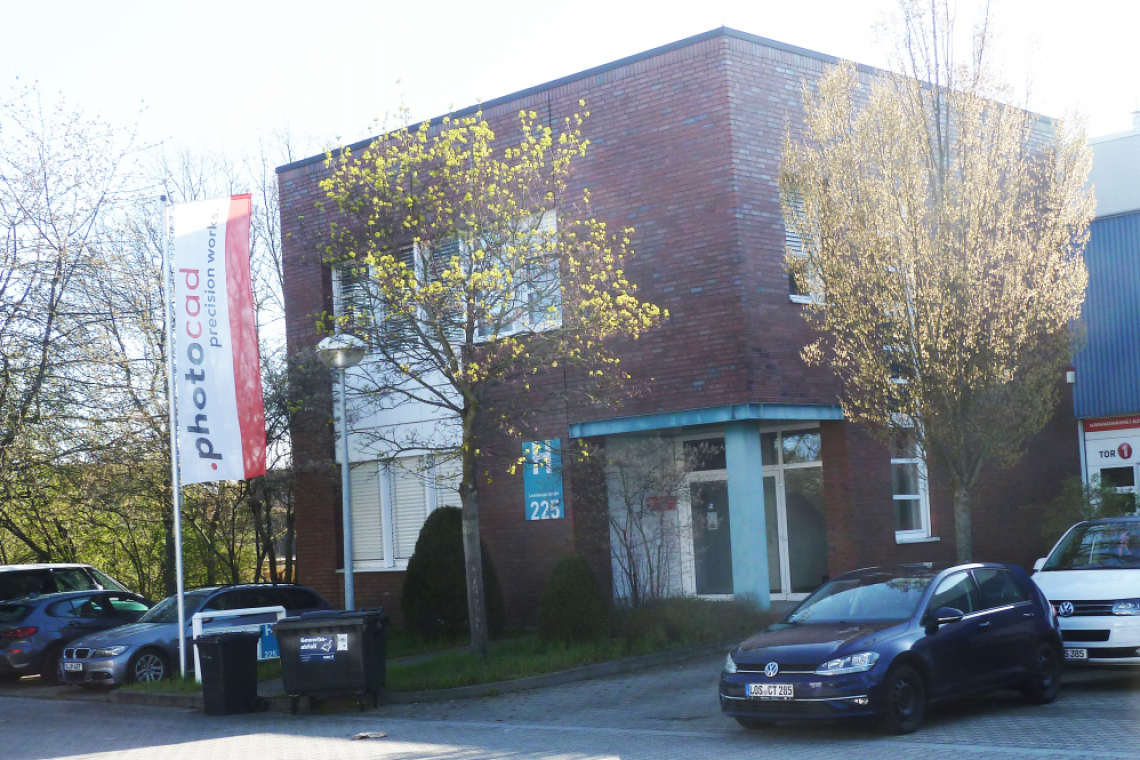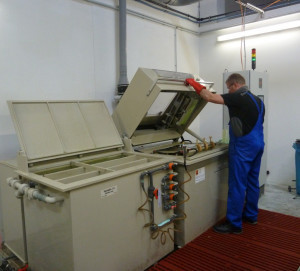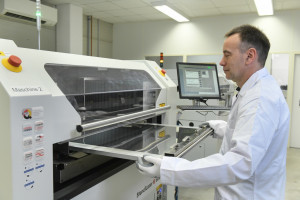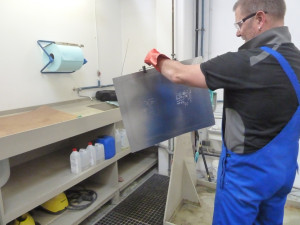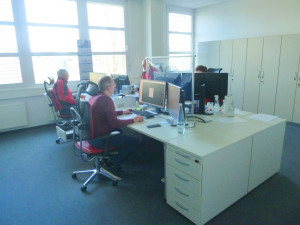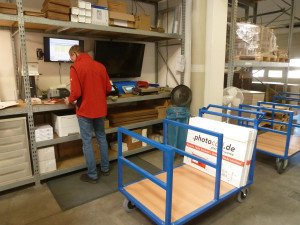Order SMD stencils online and receive them the same day - Photocad from Berlin advertises with this promise. The company is regarded in the industry as fast, innovative and reliable. We had the opportunity to see the SMD stencil manufacturer's working methods and production for ourselves.
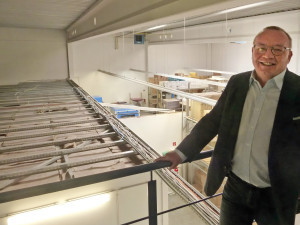 Axel Meyer gives us an insight into production - on the left in the background is the air-conditioned room cell with the laser systemsAt the end ofApril, we were able to visit the company in Berlin-Marzahn. It is located in the Landsberger Straße industrial estate, easily accessible by car or public transport. We were greeted at the entrance by a waving flag with the company logo and, after entering, by a curious little dog called Anton - and shortly afterwards by Sales Manager Axel Meyer and Managing Director Ulf Jepsen. Both took a whole morning to give us a tour of production and the back office - and to answer all our questions in detail.
Axel Meyer gives us an insight into production - on the left in the background is the air-conditioned room cell with the laser systemsAt the end ofApril, we were able to visit the company in Berlin-Marzahn. It is located in the Landsberger Straße industrial estate, easily accessible by car or public transport. We were greeted at the entrance by a waving flag with the company logo and, after entering, by a curious little dog called Anton - and shortly afterwards by Sales Manager Axel Meyer and Managing Director Ulf Jepsen. Both took a whole morning to give us a tour of production and the back office - and to answer all our questions in detail.
Photocad was founded in 1969 and was initially dedicated to the production of molded etched parts and printed circuit boards. It later specialized in precision films for the PCB industry. The company is valued for its expertise in the production of laser-cut SMD stencils, since 2000 with the help of LPKF laser cutting technology. Since then, Photocad has further improved the tried-and-tested process and optimized production. The stencils are used in surface mounting technology (SMT) in industry, aerospace and robotics.
Production takes place in the large production hall - although the main process takes place in a cube that at first glance does not appear to be very large. The LPKF laser systems used to cut the stencils are located in the air-conditioned room cell. Photocad offers them in three versions: 'Basic Plus', 'Advanced' and 'Performance'. The former for the production of simply structured assemblies, 'Advanced' for finer structures and with additional electropolishing, 'Performance' for the smallest components and including surface finishing by electropolishing and nanocoating. Meyer showed us all three versions - they can be easily distinguished from each other by their surfaces.
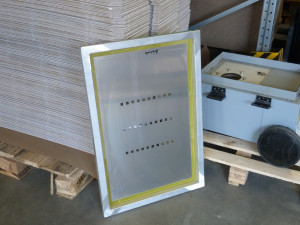 The SMD stencils are shipped in special transport packaging to protect them from damage. Parts of the high-quality packaging can be reused on return In the'cube', we witness how the stencils are laser-cut, then visually inspected, subjected to a stencil check and finally approved. Only the best quality is allowed to leave the cube at the end. The sharp edges require protection by a frame for safe handling - according to Meyer, you can otherwise "cut yourself badly" if you are careless.
The SMD stencils are shipped in special transport packaging to protect them from damage. Parts of the high-quality packaging can be reused on return In the'cube', we witness how the stencils are laser-cut, then visually inspected, subjected to a stencil check and finally approved. Only the best quality is allowed to leave the cube at the end. The sharp edges require protection by a frame for safe handling - according to Meyer, you can otherwise "cut yourself badly" if you are careless.
After production, the approved template is further treated, i.e. electropolished and nanocoated, depending on the design. The optional surface finish improves the solder paste print for certain requirements and makes the stencil more resistant.
Photocad promises 'same-day delivery' - during our visit, we actually experience how quickly the incoming order data is accepted, checked and forwarded and how quickly and precisely the stencils are produced and surface-treated. When we arrive, the first packaged SMD stencils are already waiting in a material trolley for collection. When we passed it again at the end of the tour, the trolley was still full.
We were also able to ask Axel Meyer and Ulf Jepsen questions after the tour. We were particularly interested in the step-down/step-up solutions offered by Photocad for stepped templates, i.e. when thickness gradations are required for a mixed assembly. Photocad uses two methods for this. One is the step-up stencil process, which was developed jointly with LPKF (reinforcements of 30 µm, 50 µm and 75 µm are spot-welded onto stencils). In the other process, patches of corresponding thicknesses are laser-welded onto the stencil in order to obtain the necessary variable geometry. This allows stencils to be produced both as step-up and step-down.
Jepsen and Meyer were also able to answer other questions. When asked about innovations in SMD production, they reported on the integration of RFID chips on stencils ('SmartStencil') in order to avoid errors during assembly thanks to real-time data readout. 'SmartStencil' is still on offer, but demand is no longer as high as it once was. But the RFID integration shows the company's wealth of ideas.
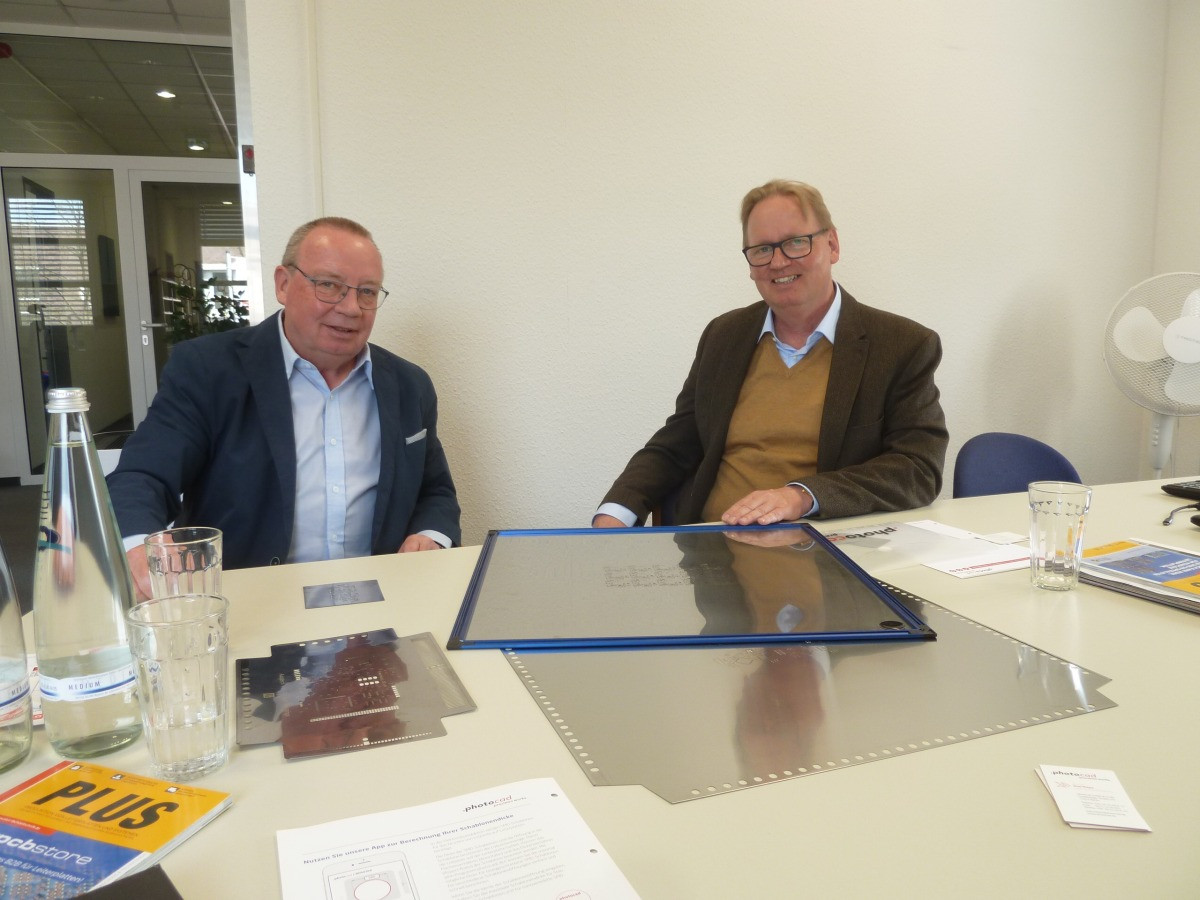 Axel Meyer (Sales Manager) and Ulf Jepsen (Managing Director) from Photocad show the PLUS editorial team finished stencils with and without protective framesAspart of our research into the shortage of skilled workers (issue 5/2023), we asked whether Photocad was also having difficulties recruiting staff. Ulf Jepsen agreed. The team size usually varies between ten and 15 employees, at the time of our visit there were twelve. There are currently no trainees - the job of SMD stencil production is too specialized and the corresponding job description is not easy to define. However, Photocad is committed to the further training of existing employees. Overall, the company explicitly relies on older employees - they have had the best experiences here, as 'mature semesters' quickly acquire the necessary specialist knowledge and are very flexible. Photocad itself is open to semi-flexible working hours during core working hours (if possible in the production process). This also helps to retain employees.
Axel Meyer (Sales Manager) and Ulf Jepsen (Managing Director) from Photocad show the PLUS editorial team finished stencils with and without protective framesAspart of our research into the shortage of skilled workers (issue 5/2023), we asked whether Photocad was also having difficulties recruiting staff. Ulf Jepsen agreed. The team size usually varies between ten and 15 employees, at the time of our visit there were twelve. There are currently no trainees - the job of SMD stencil production is too specialized and the corresponding job description is not easy to define. However, Photocad is committed to the further training of existing employees. Overall, the company explicitly relies on older employees - they have had the best experiences here, as 'mature semesters' quickly acquire the necessary specialist knowledge and are very flexible. Photocad itself is open to semi-flexible working hours during core working hours (if possible in the production process). This also helps to retain employees.
When asked about the 'hot potato' of recent years, namely faltering supply chains and component shortages, Jepsen and Meyer revealed that this has not had a negative impact on Photocad - on the contrary. If components are missing, it is much more necessary to adapt the assembly and use new stencils for this. Photocad supports its customers with help and advice. 90% of these customers come from Germany, 8% from Austria and Switzerland and the rest from other eurozone countries.
All in all, an exciting company visit to a friendly and innovative company. We are curious to see what news we will hear from Photocad in the coming years.

